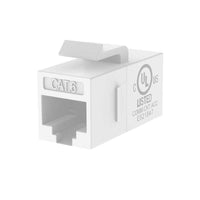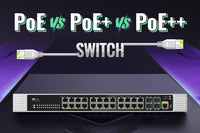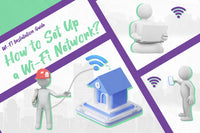Introduction
If you’re exploring ways to renovate your home or commercial space, updating the lighting can be a wonderful place to start—amazing how much of a difference it can make. Understanding the differences between PoE lighting and traditional lighting helps you make smarter installation or upgrade choices. In this guide, we’ll see the differences between the two systems in:
- Wiring
- Connectivity
- Control
Interesting Fact: As a U.S. Department of Energy report on LED adoption reported, LEDs save massive amounts of energy compared to fluorescent and incandescent lamps. When combined with connected controls like PoE lighting systems, the potential efficiency increases significantly.
PoE Lighting Replacing Traditional Lighting Systems
Lighting technology has come a long way over the years. The steps of its evolution are:
- First stage: High-voltage AC circuits
- Second stage: Energy-efficient LEDs
- Latest stage: Power over Ethernet (PoE)
PoE is a modern, smart solution that delivers both power and data through a single Ethernet cable—turning regular lights into connected, intelligent devices that are easier to manage and more versatile.
Expert Tip:
If you're thinking about upgrading, a great first step is to take stock of your current setup. Just take a moment to note where your switches, fixtures, and ceiling access points are located. Doing this ahead of time can help you estimate how many PoE ports you’ll need—and save you from any unexpected work down the road.
Why This Comparison Matters: Wiring, Connectivity, and Smart Building Integration
Understanding the differences between PoE lighting and traditional lighting goes beyond just knowing the technical specs—its about seeing how each option can better support your space and needs. It is having the knowledge to make the right choice for your building, as they differ in several aspects such as wiring, connectivity, and smart integration.
Wiring
- Traditional lighting systems rely on thick copper conductors and separate high-voltage electrical circuits for each zone or switch.
- PoE lighting uses low-voltage Ethernet cabling (like Cat5e, Cat6, or Cat6a). It carries both power and data through a single line. This simplifies installation and cuts material costs.
Connectivity
Traditional lighting systems connect through dedicated electrical cabling and wall switches. This limits flexibility and automation.
PoE lighting directly integrates into the IT network. This allows centralized monitoring and eases control and remote configuration through dashboards.
Smart building integration
- Traditional lighting usually operates with minimal communication between fixtures or systems, meaning each component works on its own.
- PoE lighting systems connect with smart building systems. They integrate with HVAC and security sensors to enable Internet of Things-driven automation and innovative energy analytics.
Scalability and maintenance
- Traditional systems tend to require physical rewiring for upgrades or layout modifications.
- PoE lighting can be reconfigured from a central dashboard. This reduces downtime and maintenance costs.
Interesting Fact: As published by the DesignLights Consortium, connected lighting systems can reduce total energy consumption by about 50% and overall building energy use by up to 10%.
What Is Traditional Lighting?
Traditional lighting refers to the long-established electrical systems that power most residences and commercial spaces. These setups work with high-voltage wiring and manual controls (like when you flip a wall switch and it directly turns the lights on or off, dimmers, or relay-based circuits). Upgrades generally require additional wiring.
How Traditional Lighting Works
Traditional systems are powered by AC mains voltage (typically 120-277V). In the U.S., 120V is the standard voltage for homes and small businesses and 277V is used in commercial and industrial facilities.
These traditional lighting systems use electrical current to generate light through the discharge of heat or gas:
- Incandescent bulbs produce light by heating a tungsten filament till it glows. Although this results in a warm light, it’s not efficient because the process wastes most energy in the form of heat rather than illumination.
- Fluorescent lights work by passing an electric current through a gas, which creates ultraviolet light. That UV light then gently excites a phosphor coating inside the tube, bringing forth visible light in a simple yet effective way.
Both technologies consume more energy and produce more heat than PoE-based systems.
What Is PoE Lighting?
First, let’s clarify the basics of Power over Ethernet (PoE). PoE is the technology that enables both electricity and network data to travel to the same Ethernet cable. It eliminates the need for separate cabling, and this innovative technology has also been successfully integrated into lighting systems. Instead of old-style high-voltage circuits, PoE delivers low-voltage DC power through network switches. This makes lighting installations safer and easier to control.
How PoE Lighting Works
PoE lighting systems use Ethernet cables to transmit power and data to LED fixtures. LED fixtures are lighting devices that use light-emitting diodes (LEDs) to produce illumination for a wide range of indoor and outdoor applications. A PoE switch and injector delivers low-voltage DC over twisted-pair copper to each fixture or powered device (PD).
This system automatically negotiates power level securely. It classifies each connection so the Power Sourcing Equipment (PSE) can transmit the proper wattage to each device. At the same time, the IP network enables managing everything through software.
Cabling Requirements
1- Traditional Lighting Cabling
- High-voltage circuits with THHN or NM cables
- Conduits and junction boxes per code
- Separate runs for power and control
- Requires licensed electricians and inspections under NEC
2- PoE Lighting Cabling
- Low-voltage structured cabling for PoE lighting (Cat5e or higher) to carry power and data on the same cable
- Standard Ethernet channel length up to 100m (328 ft), including patch cords
- Use Cat6a in high power settings to diminish the risk of temperature escalation and crosstalk, and to preserve 10G performance
- Separate from AC power where needed, respect bend radius, and label both ends
- Low-voltage technicians can install and test them, as well as certify links
Uses of Ethernet Cabling (Cat5e, Cat6, Cat6a) in PoE lighting:
PoE lighting uses Ethernet cabling (Cat5e, Cat6, Cat6a) to deliver power and data through a single line.
- Cat5e: Is acceptable for lower-power PoE; tighter thermal margins in large bundles
- Cat6: Is the common +starting point for PoE/PoE+ with improved crosstalk performance
- Cat6a: Is endorsed for PoE++ and future-proofing; better thermal headroom and 10G up to 100 m
Centralized Control, Remote Management, IoT Integration in PoE Lighting
Since PoE lighting fixtures connect to the building’s IP network, each endpoint can be:
- Monitored and managed remotely, providing real-time data on the status, energy consumption, and faults
- Scheduled or grouped through software dashboards or Building Management Systems
- Flawlessly integrated with IoT sensors (such as motion, occupancy, daylight) to allow automation, adaptive dimming, and energy optimization
Key Components of Traditional and PoE Lighting Systems
Traditional Lighting Components
Traditional lighting systems use high-voltage electrical hardware manufactured to be durable and safe in alternating current (AC) circuits. Traditional systems' key components include:
- Circuit breakers and electrical panels are necessary to distribute 120-277V power across lighting zones.
- Switches and dimmers provide local manual control.
- Junction boxes are utilized to protect wire connections and splices.
- Ballasts and fixtures are needed to convert voltage into the proper levels, for example, for fluorescent lamps.
- Cabling and connectors. Usually, 12-14 AWG copper conductors are enclosed in conduits or non-metallic (NM) sheathing to comply with NEC standards.
PoE Lighting Components
PoE lighting systems use network components that transmit data and low-voltage power. The key components are:
- PoE switches or injectors (PSE) supply negotiated DC power and Ethernet data to each device
- Patch panels are used to centralize terminations and make fixes or changes easier.
- Keystone jacks and RJ45 connectors are important elements that guarantee consistent terminations that comply with the industry standards for each Ethernet run.
- Labeling and cable managers are useful to keep bend radius, improve airflow inside racks and help to make maintenance tasks faster.
- Fixtures and PoE drivers are needed to convert low-voltage DC into usable power for LEDs.
Expert Tip:
Be sure to label each PoE port and lighting fixture at both ends. Labeling helps to make fixing and maintenance tasks simpler and reduces downtime.
Connectivity and Control
Traditional Lighting
In a traditional setup, we manage lighting through manual switches or analog dimmers, which means we control it locally. If you want remote control and automation, for example, to schedule lights or adjust brightness, you’ll need additional wiring and separate control systems. These will be most likely costly and complex to install.
PoE Lighting
With PoE lighting, fixtures are IP-enabled and linked to the network. This lets you manage your system from a software dashboard or a building management system. It’s easy to dim, group, or schedule lights remotely. Moreover, when paired with sensors, the system can adjust itself automatically depending on daylight levels, energy usage, or occupancy. Definitely, a smarter and more efficient lighting system.
Advantages of PoE Lighting Summarized
- Unified power and data cabling
- Installation is faster and easier
- Control can be centralized through software dashboards or apps
- Real-time monitoring and analytics
- Maintenance costs are lower
- You’ll be future proof and IoT-ready
Challenges of PoE Lighting Systems
Although PoE lighting brings many advantages, there are some considerations you’d better keep in mind:
The initial costs can be higher. This is because of the need for PoE switches and special cabling
The wattage is limited. It can deliver a maximum power of around 90 W per port at the PSE under the IEEE 802.3bt standard. This limits the functioning of high-power applications.
There may be compatibility issues in retrofits. Older buildings may require infrastructure changes or adjustments to support PoE.
IT integration. Since PoE lighting runs on the network, it necessitates proper IT setup and thorough security planning to grant flawless and safe functioning.
PoE Lighting vs Traditional Lighting: Brief Comparison
|
Factor |
Traditional Lighting |
PoE Lighting |
|
Cabling |
12–14 AWG copper, separate circuits |
Cat6/Cat6A Ethernet (power + data) |
|
Installation labor |
Only allows licensed electricians to do it |
Low-voltage technicians are allowed to do the work |
|
Flexibility |
Limited; rewiring required |
High; allows to be reprogramed via software |
|
Upfront cost |
Lower |
Slightly higher |
|
Long-term savings |
Moderate |
Significant (in energy + maintenance) |
Conclusion
The debate between PoE lighting vs. traditional lighting comes down to three main areas:
- Cabling
- Connectivity
- Control
Traditional lighting systems depend on separate wiring for power and data transmission and require manual control, while PoE lighting transmits power and data through a single Ethernet connection. This creates a smarter, more efficient and easier-to-manage environment.
If you want centralized control, real-time insights, and easy scalability, PoE lighting is the smarter way to go. Yet, for small retrofits or individual spaces, traditional wiring may be the most practical choice.
The best strategy to design your infrastructure, however, is to think of the future. If your systems are prepared, when technology advances, you’ll be able to upgrade easily. With this in mind, consider PoE lighting for a future-proof smart solution.






Be the first one to comment.
Leave a comment